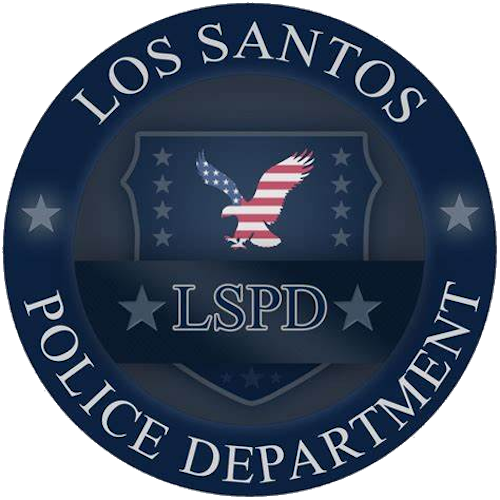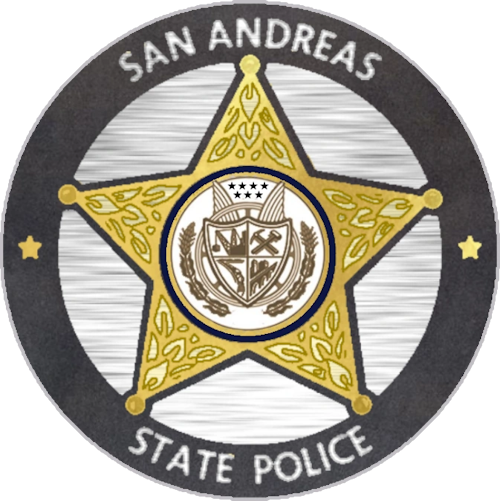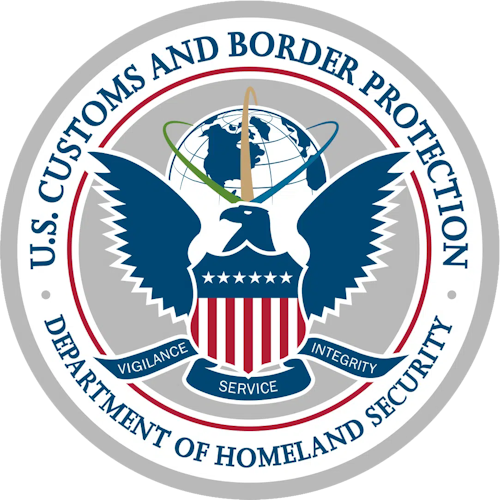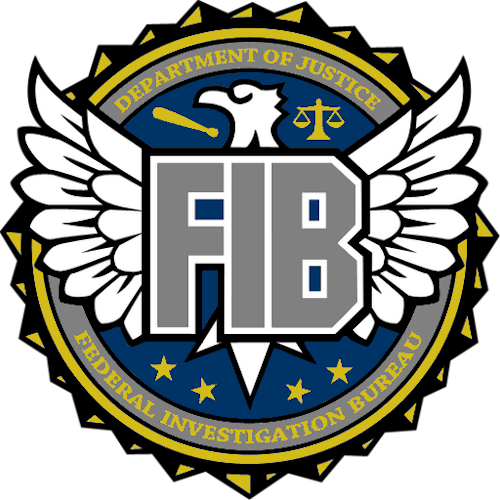There are several law enforcement agencies present in this city. Below is a list of them and a short description of their duties and Aresponsibilities:

Los Santos Police Department. The LSPD maintains primary jurisdiction within the City of Los Santos. The LSPD is responsible for all law enforcement activities within city limits.

San Andreas State Police. The SASP maintains primary jurisdiction across the entire state of San Andreas, and secondary jurisdiction within the City of Los Santos behind the LSPD. The SASP is responsible for all law enforcement activities within the entire state, and supports the LSPD within city limits as necessary.

US Customs and Border Protection. The USCBP maintains primary jurisdiction on all ports of entry and coastline of the state of San Andreas, including ¼ mile inland of any port or coastline, as well as the entire length of the bridge to Cayo Perico. The USCBP may perform any law enforcement activity within their jurisdiction with the support of the LSPD and SASP as necessary, but is primarily concerned with the trafficking of contraband into the state, and ascertaining legal status of individuals entering the state. The USCBP can also acts as a liaison to the Cayo Perico Police Department.

Federal Investigation Bureau. The FIB maintains primary jurisdiction within the entire state of San Andreas. The FIB’s primary responsibility is to act in the capacity of the Internal Affairs for all other police forces in the state of San Andreas (not including the CPPD), but may perform any law enforcement activity within the state as necessary. The FIB can also act as a liaison to the Cayo Perico Police Department
- Cayo Perico Military Police. The CPMP maintains primary jurisdiction of the island of Cayo Perico and is the only law enforcement agency present on the island. See further below for more information about the CPMP.
Understanding your role.
The role of any law enforcement officer in this city is two fold. We expect you to:
- Provide good and engaging RP with all citizens within the city, and
- Serve as an obstacle to civilians engaging in illegal activity.
At no time should you expect that you must “win” when in a scene with other civilians. Our goal as law enforcement is not to “win,” it is to be a tough but fair obstacle to overcome to the criminal underground of the city.
We are here to provide risk, not to punish. There will be plenty of times that you will catch the bad guy, but there will also be plenty of times that you don’t. No officer in our city is judged by how many criminals they do or do not catch. You will be judged by your ability to provide high quality engaging RP, by your commitment to your department, and by your willingness to sometimes (or even oftentimes) take the “L” and move on to the next scene or to your idle time duties.
You will find in the SOPs below that you will have incredible freedom as well as a myriad of tools available to you to be tactical with how you approach your interactions with criminals in the city. We encourage you to maintain a good attitude when you don’t catch them, and use the experience to come up with more clever ways to catch them next time.
Code of Conduct
- You must follow all the same city rules as other civilians.
- Professionalism: Officers are expected to conduct themselves with respect, integrity, and professionalism at all times, both in-game and in interactions with others.
- Roleplaying: Officers must adhere to roleplay standards. This includes staying in-character and responding appropriately to situations based on their training and experience.
- Respect for Civilians and Other Players: Officers are expected to treat civilians and fellow officers with respect, and any form of harassment or inappropriate behavior will not be tolerated.
- No Meta-Gaming: Officers are prohibited from using out-of-character knowledge to influence in-character decisions or actions.
- Follow your specific department’s SOPs at all times.
- Radio. If you’re on duty, you must be in Radio Channel 1 (except CPPD)
Interacting with Suspected Criminals
The goal here at BackdraftRP is to foster an RP experience that is very freeform and allows for as much creativity as possible. Please adhere to the following guidelines when interacting with suspects as a law enforcement officer in our community.
- “Yes, and…” is a rule-of-thumb we have adapted from improvisational comedy. It suggests that an officer should accept what another civilian has stated (“yes”) and then expand on that line of thinking (“and”). This does not mean that you cannot disagree with or question that civilian’s statements, but that you should not reject the basic premises introduced by that civilian, as this would throw them off and harm the flow of the scene.
- Even if you know that a civilian has committed a crime, you are not required to always arrest them. If a civilian offers you a good story, is able to answer all your questions, and overall provides good RP with you, you are encouraged to go along with it and let them go. You will never be judged or reprimanded by how many people you do or don’t arrest, only by how creative and engaging your RP is.
- Probable Cause. You must establish and be able to articulate probable cause before you are allowed to search a civilian or a vehicle. Just being in the area of a dispatch does not constitute probable cause; however, you may detain and question individuals in the area and try to trip them up in your questioning to get them to say something that will give you probable cause.
- Witnessing a crime in progress fulfills probable cause.
- Suspects attacking you in any way fulfills probable cause.
- Suspects fleeing from you when making initial contact or during contact fulfills probable cause.
- Admissions of illegal activity fulfills probable cause.
- DMV officers may search commercial or work vehicles without probable cause.
- USCBP officers may search any vehicle without probable cause if within ¼ mile of a coastline or port of entry.
- Use of force. All care must be taken to exercise your duties with the minimum amount of force required.
- There are no requirements for a civilian to fire a weapon at you; they may do so at any time (RDM not included). Be mindful of this on your patrols.
- You may pull your own weapon and fire on a civilian if they brandish a weapon in your presence.
- You may not fire on a civilian who is not brandishing a lethal weapon.
- If you are being threatened with fists or melee weapons, you may make use of any of your non-lethal weapons to quell the suspect.
- Being fired upon allows all other officers in the city to come to your aid. Use your /panic to alert them.
- Fearing for your life. You are expected to be fearful of your own life just as any other civilian. If you are being threatened and are outnumbered, you are expected to comply. You may also use your /panic to alert other officers that you are in danger.
- If you are put on your side in a scene, you are considered to be out of the scene. If you are revived by medical personnel, you must leave the area.
- All robberies are considered “smash-and-grab.” Criminals are not required to wait for you to arrive, nor are they required to engage in conversation with you if they so choose.
- Expect to be fired upon when responding to robberies. Employ good tactics and planning to avoid being injured. Use your car for cover, use your megaphone to communicate with suspects, and remember that there’s strength in numbers. Lone cops make for easy targets.
- When responding to Robberies, there are no limits on what tactics you employ to apprehend a suspect. Besides Use of Force rules, there are no limitations in how you choose to respond to nearly any scene. You may wait them out and give chase, you may breach the premises, you may employ whatever tactics you see fit to apprehend the suspect(s).
- In a high speed chase, there is no requirement to leave the chase from vehicle damage. The city is coded to disable your vehicle if it believes your vehicle has taken too much damage.
- In a high speed chase, there are no timers or limitations on tactics. Officers may choose to use PIT maneuvers or other tools at their disposal at any time. However, officers are encouraged to use caution for the reason listed above.
- In a high speed chase, criminals are allowed to fire at you from their vehicle. Rules regarding fire on officers still apply; if you’re fired upon, all other officers in the city not on that scene are allowed to attach. Be sure to let your fellow officers know that you’re being fired on.
- San Andreas based police departments are not allowed to enter Cayo Perico without the express permission of the CPMP. Officers from any of the San Andreas police departments are only allowed up to where the bridge meets the island.
Idle Activities
As a law enforcement officer here at BackdraftRP, your duties do not end when the scenes end. Between dispatch calls, there are several other activities that are available to officers during “downtime.”
- Patrolling your AOP. Officers shouldn’t always just sit in one place and wait for dispatch calls. Officers should actively patrol their AOPs and stay on the lookout for criminal activity. Any and all blips on the map that denote illegal activity are considered known to the police. Patrolling these areas should be part of your everyday activities.
- Make sure your paperwork is in good order. All incidents should be documented thoroughly in the MDT. Incidents in the MDT are editable, so you should take time and make sure all of your paperwork in the MDT is in good order.
- Investigative work. You are encouraged to pursue investigations into individuals, gangs, groups, or businesses.
- Gathering intel such as plate numbers, names, locations, activity, etc. and documenting your findings in the MDT can result in law enforcement being able to execute search warrants or conduct raids, which may result in large seizures of contraband. Such investigative work in your “downtime” is highly encouraged.
- You can team up with fellow officers to perform stakeouts and cooperate on building a case to allow for a warrant or raid.
- You can coordinate with other departments through your high command to establish task forces to target specific cases, individuals, gangs or groups.
- Undercover work. Undercover officers are allowed. Undercover activities must be authorized by the high command of the department you’re a part of in order to decide the depth and scope of an undercover assignment.
- Gang Enforcement. The city recognizes gangs and allows them to assert influence over sections of the city, allowing them greater rewards such as better drug sell prices and being able to collect protection money from local businesses. Patrolling gang controlled areas, as well as cleaning up graffiti, reduces and can possibly even remove a gang’s influence over an area. Check with your high command to make sure you’re part of the LEO gang.
Cayo Perico / San Andreas Border
- The border on the Cayo Perico side is considered to be where the asphalt ends.
- The border on the San Andreas side is considered to be the gates at the end of the bridge.
- The bridge itself is considered to be under the jurisdiction of both the CPPD and the San Andreas police departments.
Cayo Perico Military Police (CPMP)
The Cayo Perico Military Police, or CPMP, is the primary and sole police force active on the island of Cayo Perico. Cayo Perico is not a part of San Andreas, and is considered to be a foreign county. Cayo Perico is a police state, and as such, the CPMP have an entirely different set of rules from the other departments.
***Note that the following rules regarding the CPMP are subject to change at any time. We consider our implementation of the CPMP to be experimental and reserve the right to make any changes we see fit to hinder abuse of these rules as much as possible. Our goal here is to provide a different type of RP that is typically not allowed in other cities, however we are cautious of people taking advantage of this very different ruleset.
- The CPMP is a corrupt police force. CPMP officers are allowed to accept bribes, turn the other cheek on crime, or otherwise be more or less friendly to criminals on the island as they see fit or as the RP allows.
- CPMP Officers are not allowed to directly commit crimes themselves. You may not rob stores or banks, craft drugs, or engage in other directly illegal activity while on duty. While the CPMP is allowed to be corrupt, they are still considered a police force, and any crimes committed by the CPMP must not be overt.
- CPMP Officers are forbidden from entering San Andreas without the express permission of the USCBP or the FIB. Because Cayo Perico is considered a foreign country, the CPMP has no authority or jurisdiction within the state of San Andreas. If the CPMP desire to enter San Andreas as part of their own criminal investigation, they can request a joint operation with an FIB Agent or USCBP Agent. The terms of such an operation can be discussed and agreed upon by the respective departments as long as all other rules are followed. CPMP Officers present on San Andreas soil must abide by San Andreas police SOP’s.
- The CPMP does not receive dispatch alerts for crimes committed on the island. Because Cayo Perico is a police state, the locals are unfriendly to and fearful of the local police. Thus, they will not report crimes that they witness. It is up to the officers on the island to uncover criminal activities themselves.
- Citizens do not have the same rights on Cayo Perico as they do in San Andreas. As a CPMP officer, you are not required to have probable cause to search or detain a civilian on the island. Detaining a civilian must only last for a reasonable amount of time as dictated by the RP. You may not indefinitely detain a civilian on the island.
- You must still follow Use of Force rules. You may not randomly gun down other civilians without RP for no reason, as this would be considered RDM. However, because Cayo Perico is a police state, you may conduct all of your patrols with a weapon out, and you may use the threat of your weapon to encourage civilians to comply with your orders.
- CPMP jurisdiction ends at the beginning of the bridge. The whole of the bridge is considered to be part of San Andreas and is under the jurisdiction of the San Andreas based police departments.
- San Andreas based police departments are not allowed to enter Cayo Perico without the express permission of the CPMP. Officers from any of the San Andreas police departments are only allowed up to where the bridge meets the island.